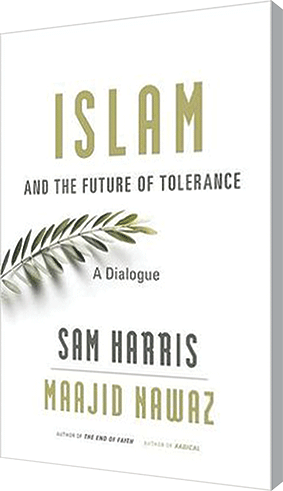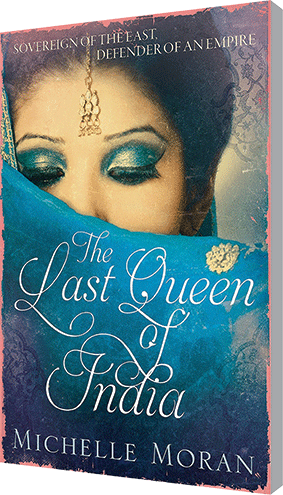Islam and The Future of Tolerance — A Dialogue by Sam Harris & Maajid Nawaz Harvard University Press; Price: Rs.859; Pages: 138
 Sam Harris is a well-known American atheist ideologue. Maajid Nawaz is a former Islamist activist who experienced a momentous change of heart and mind and is now member of a circle of reformers committed to combating Muslim extremism, deradicalising Muslim youth and promoting Islamic reform.
Sam Harris is a well-known American atheist ideologue. Maajid Nawaz is a former Islamist activist who experienced a momentous change of heart and mind and is now member of a circle of reformers committed to combating Muslim extremism, deradicalising Muslim youth and promoting Islamic reform.
This slim book documents a dialogue between the two about issues of great import for the future of Islam and Muslims in a rapidly globalising world. Harris raises thought-provoking questions — such as indiscriminate atrocities in the name of Islam and Muslim attitudes towards people of other creeds. Responding, Nawaz acknowledges the gravity of the challenges, highlights the possibility of using Islamic arguments to counter religious extremism and reflects on the need to foster secularism, democracy and human rights in Muslim societies trapped in conformity.
The amicable exchanges between the two scholars reveal that although their appreciation and understanding of religiosity may differ radically on many points, a confirmed atheist and a religious reformer can find sufficient common ground to have an engaging and meaningful dialogue towards commitment to peace, democracy, secularism (understood as separation of religion and state) and justice.
Today, the violence flowing out of extremism and terrorism in the cause of Islam is a global issue of grave concern. The conversation between Harris and Nawaz focuses mainly on this subject.
Harris argues that contrary to the claim of Muslim reformists, Islam is not a religion of peace. He contends instead that Islamic extremists are “implementing what is arguably the most honest reading of the faith’s actual doctrine”. Nawaz responds by pointing out that “polarisation of this debate between those who insist that Islam is a religion of war and proceed to engage in war for it, and those who insist that Islam is a religion of war and proceed to engage in war against it” has led to an intractable situation, adding that religious texts can be diversely understood and that they need to be interpreted.
The Quran, like any other text (religious or otherwise) can be interpreted in various different, often mutually-contradictory ways. If radical Islamists champion a violence-driven, politics-centric interpretation of the holy book, Muslim reformists articulate diametrically different readings of Islam, rooted in peace and harmony. What people read into a text depends heavily on their cultural and ideological baggage.
The thrust of peacenik Nawaz’s case is that multiple interpretations of any scripture (or any other text for that matter) are inevitable. Hence, he says, “all variant readings of a holy book become a matter of differing human perspectives”. He challenges the claim of militant Wahhabists to be in possession of the Absolute Truth, and contends that several verses in the Holy Quran, as well as many hadiths attributed to Prophet Muhammad, propagate peace, compassion and friendly relations between Muslims and people of other faiths. “The best way to undermine extremists’ insistence that truth is on their side is to argue that theirs is merely one way of looking at things,” he suggests.
Nawaz also urges a transformation in the way people relate to religion. He advises moving away from viewing religion as a set of injunctions and observance of strict legal rules. It should be regardded more positively as “a spiritual, mystical relationship with God, a journey”. In this light, he believes the Sufi tradition within Islam offers several reformist inputs for rigid Sunni Islam.
Acknowledging the magnitude of the global challenge posed by radical Islamists, Nawaz advocates an urgent need for Muslim reformists to articulate and popularise alternate interpretations of Islam to counter the machinations of hardliners who have ruined the reputation of an enlightened creed. In the middle ages, right until the end of the 16th century, Muslim scholars contributed substantially to the development of philosophy, mathematics, medicine and the sciences in the Middle East and Europe. Advocacy of liberal interpretations and understanding of Islam and the Quran are necessary to counter human rights abuses in the name of Islam as well as to facilitate new thinking on issues such as apostasy, women’s rights and peaceful coexistence with people of all faiths.
Islam and the Future of Tolerance is a treasure trove of scholarly insights packed into a few dozen pages. A must-read for people interested in issues of global importance.
Roshan Shah
Last days of Jhansi
The Last Queen of India by Michelle Moran Quercus Editions Limited; Price: Rs.399; Pages: 352
The Last Queen of India is an engaging piece of historical fiction. The novel revolves around the life of Rani Lakshmi Bai of Jhansi, and chronicles the period of the Great Revolt of 1857. While many of the characters around whom the story revolves in the novel existed and are documented with various degrees of accuracy in historical records, the protagonist seems to be an entirely fictional construct of the author.
Sita, the medium through which the story is told, starts out as a young girl who manages to enlist with the Queen’s all-female bodyguard called the Durga Dal. The novel is presented in the form of memoirs and recollections of Sita writing many years after the events, thus framing the first person narrative that the author favours.
The story can broadly be divided into four parts. In the first, we are introduced to Sita and her family, with the introduction serving to help the reader to become familiar with her society and its customs and traditions. It focuses on Sita growing up in a small village, conflicts within her family, and her efforts to break away from the restrictions her culture and draconian grandmother impose upon her. She achieves this by joining the Queen’s bodyguard.
The second part of the story shifts to Jhansi, where we witness this village girl dealing with the pressures and politics of a 19th century Indian city. In the background the principality of Jhansi, as well as the rest of the country, is slowly marching towards the Sepoy Mutiny of 1857, aka India’s first war of independence.
The last section of the book sees Sita leaving Lakshmi Bai’s side to deal with the impact that British policy and the Mutiny have had on her family, and thus reports the final days of Lakshmi Bai. It also recounts Sita and her family having to deal with the savage reprisals visited upon the natives by the ‘Red Devils’ of the East India Company.
The story that Moran weaves is compelling, exposing the reader to the dark villainies of British policies in the lead up to, as well as the aftermath of the Mutiny. The primary antagonist of her story is the East India Company as well as the British Empire, while the individuals who are secondary antagonists are scheming individuals within the Queen’s court. Moran’s characterisation of the imperialists is not comedic, nor does it suffer from lack of nuance. Not all British are uniformly evil, with at least one British character working hard with the protagonists, while others are less proactive.
The victimisation of British citizens in the course of the revolt is not glossed over or cheapened. Nonetheless Moran manages to adequately convey the shocking evil and institutional callousness of the British, that led to the revolt of 1857. The infamous Circular Memorandum of the period in particular is woven into the story as it plays havoc with Sita’s family. The reader is introduced to a tool of imperial policy that one would not generally encounter outside specialised history texts, and yet is as nefarious as the policy of ‘comfort women’ that Japan institutionalised in World War II.
The Last Queen of India is therefore not a simple story, weaving a narrative filled with simplistic good and evil individuals. Politics at the individual level, as well as politics between states is nuanced and well-constructed. The heroes, as also the victims and villains, are well defined. It speaks well of Moran’s capability as a narrator and author to be able to reconcile a relatively simplified narrative of good and evil, and yet imbue her characters on both sides with the complexities required to make them real historical individuals, rather than caricatures. Lakshmi Bai is not a superheroesque character, but neither is she overly flawed or rendered irrelevant by a fictional protagonist.
This novel is likely to appeal to a large audience. To a non-Indian readership wholly unfamiliar with Indian history or the specific events of 1857, it is likely to prove to be a compelling story of trials and tribulations set in an exotic backdrop. For those more familiar with the history of the British Raj and empire, this narrative brings alive an interesting period of history, one removed from aspects that have traditionally received attention, such as Delhi.
It’s the author’s skill that she is able to narrate a well-written story without verbosity, while managing to do justice to history and the demands of modern readers.
T.C.A. Achintya (The Book Review, September 2016).